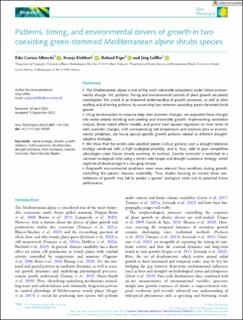| dc.contributor.author | Albrecht, Eike Corina | |
| dc.contributor.author | Dobbert, Svenja | |
| dc.contributor.author | Pape, Roland | |
| dc.contributor.author | Löffler, Jörg | |
| dc.date.accessioned | 2024-04-22T13:10:38Z | |
| dc.date.available | 2024-04-22T13:10:38Z | |
| dc.date.created | 2023-10-10T09:37:05Z | |
| dc.date.issued | 2023 | |
| dc.identifier.citation | Albrecht, E. C., Dobbert, S., Pape, R., & Löffler, J. (2024). Patterns, timing, and environmental drivers of growth in two coexisting green-stemmed Mediterranean alpine shrubs species. New Phytologist, 241(1), 114-130. | en_US |
| dc.identifier.issn | 0028-646X | |
| dc.identifier.uri | https://hdl.handle.net/11250/3127675 | |
| dc.description.abstract | The Mediterranean alpine is one of the most vulnerable ecosystems under future environmental change. Yet, patterns, timing and environmental controls of plant growth are poorly investigated. We aimed at an improved understanding of growth processes, as well as stem swelling and shrinking patterns, by examining two common coexisting green-stemmed shrub species.
Using dendrometers to measure daily stem diameter changes, we separated these changes into water-related shrinking and swelling and irreversible growth. Implementing correlation analysis, linear mixed effects models, and partial least squares regression on time series of stem diameter changes, with corresponding soil temperature and moisture data as environmental predictors, we found species-specific growth patterns related to different drought-adaptive strategies.
We show that the winter-cold-adapted species Cytisus galianoi uses a drought tolerance strategy combined with a high ecological plasticity, and is, thus, able to gain competitive advantages under future climate warming. In contrast, Genista versicolor is restricted to a narrower ecological niche using a winter-cold escape and drought avoidance strategy, which might be of disadvantage in a changing climate.
Pregrowth environmental conditions were more relevant than conditions during growth, controlling the species' resource availability. Thus, studies focusing on current driver constellations of growth may fail to predict a species’ ecological niche and its potential future performance. | en_US |
| dc.language.iso | eng | en_US |
| dc.rights | Attribution-NonCommercial-NoDerivatives 4.0 Internasjonal | * |
| dc.rights.uri | http://creativecommons.org/licenses/by-nc-nd/4.0/deed.no | * |
| dc.title | Patterns, timing, and environmental drivers of growth in two coexisting green-stemmed Mediterranean alpine shrubs species | en_US |
| dc.type | Peer reviewed | en_US |
| dc.type | Journal article | en_US |
| dc.description.version | publishedVersion | en_US |
| dc.rights.holder | © 2023 The Authors. | en_US |
| dc.source.pagenumber | 114-130 | en_US |
| dc.source.volume | 241 | en_US |
| dc.source.journal | New Phytologist | en_US |
| dc.source.issue | 1 | en_US |
| dc.identifier.doi | https://doi.org/10.1111/nph.19285 | |
| dc.identifier.cristin | 2183155 | |
| cristin.ispublished | true | |
| cristin.fulltext | original | |
| cristin.qualitycode | 2 | |

